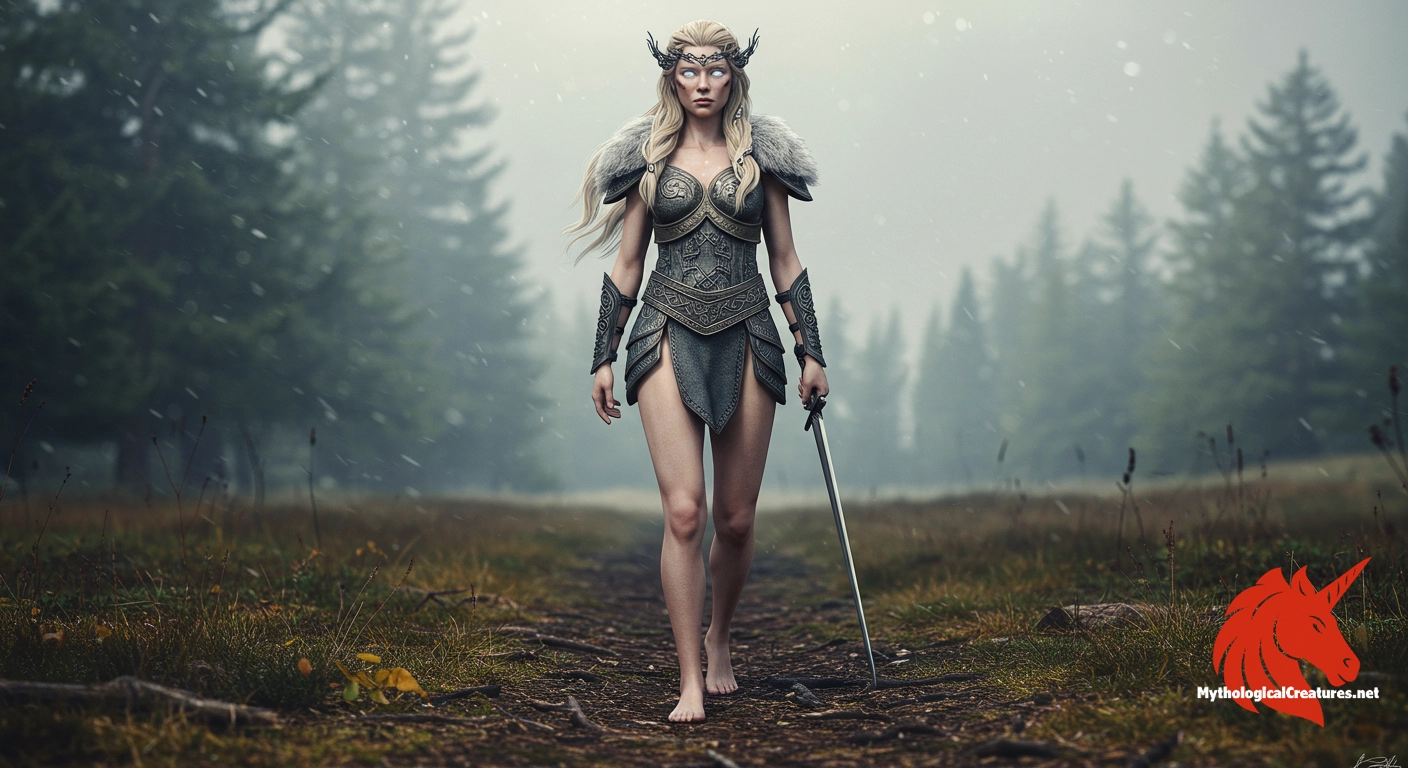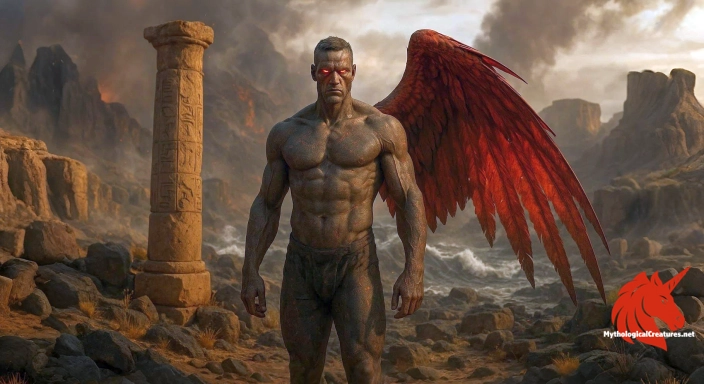Hildr: Hildr is a Norse valkyrie renowned for her ability to revive fallen warriors in battle.

Hildr
Hildr - Hildr embodies the perpetual nature of battle and the cyclical interplay of life and death in Norse mythology
Origins & First Encounters
Hildr emerges from the rich tapestry of Norse mythology as a formidable valkyrie whose very name translates to 'battle', setting the tone for her martial prowess and mystique. Her earliest narrative roots are found in the Prose Edda, where she is intricately entwined with the eternal confrontations of heroes and warriors. Born of the lineage tied to Högni, her origins resonate with themes of both divine intervention and mortal valor. In the unfolding saga of the Hjaðningavíg, she is endowed with the power to revive the dead, symbolising a cycle where destruction begets new conflict. This divine resurgence of fallen warriors underscores her role as a keeper of the continuum between life and death.
Her character is imbued with dual significance, representing both the raw intensity of battle and the bittersweet reality of loss and rebirth. The mythic landscapes that cradle her tales weave a narrative of relentless conflict, one that continues to echo across the ages. Beyond the battlefield, Hildr’s saga reflects a deep cultural reverence for fate and destiny, resonating with the existential questions of renewal and sacrifice. Her enduring presence in Norse lore continues to inspire and captivate, marking her as a timeless symbol of martial force and eternal recurrence. The multifaceted nature of her legend invites both admiration and introspection, making her an essential figure in the study of ancient myth.
Source Texts & Tale Variants
Ancient literary sources reveal Hildr as a character of considerable depth, her lore proliferating through the poetic cadences of Old Norse texts. The Prose Edda stands as a seminal work where her role as the orchestrator of the eternal battle is vividly described. Verses in the Völuspá and fragments found in texts like Darrañarljóð further cement her status among the host of valkyries. These accounts, while varying in detail, consistently emphasise her unique ability to reinvigorate the fallen, thereby sustaining ceaseless combat. Early oral traditions transitioned into written manuscripts, each contributing subtle nuances to her mythic persona.
Some sources even employ her name as a personification of battle itself, blurring the lines between a literal deity and an allegorical symbol. In certain texts, the interplay between her familial ties with figures such as Hedin and Högni enriches her narrative, offering multiple perspectives on her divine purpose. Variations in the recorded tales underscore the dynamic nature of Norse folklore, where the oral transmission allowed for regional and personal adaptations. Assembling these diverse strands, modern interpretations of her character strive to reconcile the poetic ambiguity found in the ancient sources with the established elements of her battle ethic. The mosaic of textual fragments ultimately paints a picture of a mythic figure whose influence is as multifarious as it is enduring.
Form & Powers
Descriptions of Hildr in Norse imagery conjure an image of a striking figure, both ethereal and formidable in her manifestation. She is often depicted as possessing a statuesque build, emanating both strength and a graceful poise that belies the ferocity of battle. Her armour, intricately decorated with ancient symbols and runic patterns, is said to shimmer under the light of twilight, as if infused with the very essence of combat. Flowing tresses, sometimes described in hues of gold or silver, frame a face marked by intense, penetrating eyes that appear to see both the mortal and divine. Such features serve as a visual testament to her dual capacity for devastation and revival.
Artistic renditions frequently include details like a hand-held spear or a gleaming sword, emblematic of her active role in the cyclical theatre of war. In certain depictions she is portrayed riding a majestic steed, a symbol of her connection to the swift currents of fate. The interplay of light and shadow across her form often evokes the transient nature of existence and the perennial cycle of battle. Her physical portrayal, though varied among sources, consistently reflects a blend of beauty, power, and the inexorable pull of destiny. These vivid attributes coalesce to reinforce her identity as both a messenger of death and an orchestrator of rebirth on the battlefield.
Regional Faces
Across the Nordic expanse, the narrative contours of Hildr have been subtly reshaped to align with local cultural sensibilities and regional mythic traditions. In Icelandic sagas, her depiction is suffused with a lyrical quality, reflecting the island’s poetic tradition and its emphasis on the heroism imbued in every battle. Scandinavian accounts, whether from Sweden, Norway, or Denmark, place a significant focus on her martial attributes, with local iconography highlighting her as a guardian of fated conflicts. Regional storytellers often differentiate her role, sometimes portraying her as more of a spectral guide who escorts warriors to realms beyond the mortal coil. This fluidity in her portrayal is indicative of how oral traditions can adapt a single myth to multiple cultural contexts.
Some traditions embellish her appearance with local heroic motifs and symbols unique to their region, lending her a bespoke identity in each narrative cycle. In certain parts of the Norse world, she is even invoked as an emblem of seasonal change, capturing the cyclical nature of both the natural world and human conflict. The regional variants of her myth underscore a common theme: the inexorable link between battle, destiny, and the renewal of life. These localized adaptations not only amplify her prominence in regional folklore but also enrich the broader tapestry of her mythos. Each retelling, while preserving her core attributes, integrates distinctive cultural colours that continue to make her legend both diverse and universally resonant.
Cultural Parallels
The figure of Hildr readily invites comparison with similar archetypes found throughout the mythological traditions of diverse cultures. Like the Celtic warrior goddess, often identified with fierce embodiments of battle and rebirth, she occupies a space where the realms of death and regeneration meet. Her power to resurrect the fallen parallels the mythic cycles observed in various indigenous traditions, where death is but a temporary state in an ongoing continuum. Comparisons with other valkyries in Norse legend further highlight how she distinguishes herself through her emphasis on eternal conflict and renewal. In many respects, Hildr encapsulates the duality of creation and destruction, a theme common to war deities across a wide cultural spectrum.
Her narrative also resonates with aspects of Greek and Roman myth, where divine figures often straddle the lines between warrior and protector, though Hildr’s focus on resuscitating the dead renders her unique. Interwoven with themes of natural cycles, her story mirrors the seasonal rites found in agrarian communities that celebrate both the harvest and the inevitable decay. While her portrayal is firmly rooted in Norse tradition, the underlying motifs of cyclical battle and metamorphosis create enduring cross-cultural linkages. These comparative insights not only accentuate her mythological importance but also underscore the universality of themes like sacrifice, transformation, and the perpetual nature of conflict. The interlacing of Hildr’s narrative with similar motifs worldwide enriches our understanding of how ancient societies conceptualised the intersection of war, fate, and rebirth.
Legacy & Modern Evolution
Over the centuries, the story of Hildr has transformed, mirroring the evolving cultural and artistic landscapes of Northern Europe and beyond. Early medieval accounts cast her as a mystical figure whose interventions in battle underscored the inevitability of fate, a portrayal that resonated deeply with the warrior ethos of the Viking age. As time advanced, literary and artistic interpretations began to infuse her legend with additional layers of symbolism, reflecting emerging ideas of renewal and existential defiance. The Romantic era, in particular, rejuvenated her image, portraying her as an embodiment of the sublime and the mysterious power inherent in the clash of life and death. This reinvention paved the way for modern reinterpretations that often view her as a symbol of resistance and the indomitable spirit of the warrior.
In contemporary culture, Hildr has found a place in various media, from novels and graphic novels to films and video games, where her character is re-imagined to reflect modern sensibilities around empowerment and transformation. These adaptations frequently highlight her role as a reviver of the fallen, thus reinforcing her association with cycles of loss and rebirth. Modern scholarly and popular discussions continue to explore the layers of meaning embedded in her myth, arguing that her legacy transcends simple narratives of war. Her story has become a bridge between ancient mythic traditions and the modern quest for identity, challenge, and renewal. Ultimately, Hildr’s evolving portrayal reaffirms her position as a timeless icon of the human struggle against the inevitability of fate, and her legend remains a potent source of inspiration and reflection.
Interesting Fact
An intriguing aspect of Hildr is her ability to sustain an everlasting battle, highlighting the Norse emphasis on the cyclic nature of conflict and the inevitable intertwining of life and death.
Quick Creature Info
Origin:
Features:
Our Mythic Legendary Rating:

Habitat:
Supernatural Powers:
Physical Attributes:
Abilities:
Behavior:
Lore:
Related Creatures, Tales or Lore
- BBrynhildr
- SSigrún
References
Discover Another Mythical Legend You May Not Have Heard Of?
Uncover the mysteries of ancient folklore and expand your knowledge of legendary beings from cultures around the world.
Dare to Meet the Abezethibou....
Curated by the Mythological Creatures Team (rev. May 2025)
